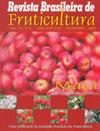电石在Cajá-manga果实成熟的预判和标准化中的应用
IF 0.9
4区 农林科学
Q4 HORTICULTURE
引用次数: 0
摘要
外源施用乙烯类似物(如电石)促进果实成熟具有商业优势。因此,了解乙烯诱导剂处理过的果实的反应对于优化这些物质的使用至关重要。本研究旨在评价电石暴露对cajá-manga果实采后成熟的预期和标准化的影响。生理成熟的果实在浓度为0、20、40、80和110 g -3的电石环境中暴露24小时。果实在28±2℃的温度下贮藏,分别在0、2、4和6天评估新鲜质量的损失、表皮和果肉的颜色(CIELAB色空间)、可滴定酸度、可溶性固形物含量、可溶性固形物含量与可滴定酸度之比和维生素C含量。Cajá-manga用不同浓度的电石处理的果实在不影响其特性的情况下提前成熟。电石浓度分别为20、40和80 g m-3,可以在4天的储藏时间内预测和标准化果实的成熟,而最高浓度(110 g m-3)可以加速果实的完全成熟,在2到4天的储藏时间内发生。本文章由计算机程序翻译,如有差异,请以英文原文为准。
Calcium carbide in anticipation and standardization of ripening in Cajá-manga fruits
Abstract Fruit ripening promoted by the exogenous application of ethylene analogs, such as calcium carbide, has commercial advantages. Thus, the knowledge of the responses of fruits treated with ethylene-inducing agents is essential to optimize the use of these substances. This work aimed to evaluate the influence of exposure to calcium carbide on the anticipation and standardization of postharvest ripening of cajá-manga fruits. Physiologically mature fruits were exposed to calcium carbide for 24 hours at concentrations 0, 20, 40, 80, and 110 g m-3. The fruits were stored at a temperature of 28±2 °C and evaluated at 0, 2, 4, and 6 days for the loss of fresh mass, color of the epidermis and pulp given by the CIELAB color space, titratable acidity, soluble solids content, the ratio between soluble solids content and titratable acidity, and vitamin C content. Cajá-manga fruits treated with different concentrations of calcium carbide had their ripening anticipated without compromising their characteristics. The concentrations of 20, 40, and 80 g m-3 of calcium carbide allowed the anticipation and standardization of fruit ripening within four days during storage, while for the highest concentration (110 g m-3), complete maturation was accelerated, occurring between two and four days of storage.
求助全文
通过发布文献求助,成功后即可免费获取论文全文。
去求助
来源期刊
CiteScore
1.50
自引率
20.00%
发文量
34
审稿时长
4-8 weeks
期刊介绍:
The Revista Brasileira de Fruticultura (RBF) publishes technical articles and scientific communications in the area of fruit crops, referring to results of original searches and unpublished papers in Portuguese, Spanish or English, and 1 or 2 reviews per edition, of invited authors.

 求助内容:
求助内容: 应助结果提醒方式:
应助结果提醒方式:


